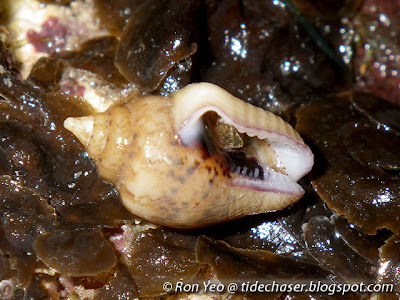Columbellid snails are also called dove snails, but I do not know why they are so named - is it because with some imagination the shell resembles the shape of a dove? The shells are usually small, thick and strong, with the outer lips are especially thickened. They have a small and elongate chitinous operculum. Dove Snails appear to have a rather diverse diet across species, with some feeding on algae, some scavenge, and others feed on sessile animals like sponges and sea anemones. They are often collected by locals for making into shell boxes or necklaces.
I have only seen three species of dove snails on our shores so far (thanks to Siong Kiat who gave tips on how to identify them!). You may want to take a look at my diagram on the parts of a snail's shell if you are not familiar with the names of the parts, so as to better understand the terms used below.

The Lightning Dove Snails (Pictocolumbella ocellata) are very common on rocky shores, easily recognised with the pale "lightning" patterns on a black background. Examination of their diet shows that they are probably herbivorous.

Occasionally, brown ones with the same lightning patterns can be seen among the black ones. The shell gets to about 1-2cm long.

Despite the common name being Lightning Dove Snails, it is often easy to find individuals with spotted patterns instead, though they are still of the same species. Apparently, some populations may be dominated by spotted ones, while others by lightning-patterned ones.

Here is a look on the underside of the the shell. The one on the left is a mature individual with a thickened outer lip, while the one on the right is an immature one. There are usually numerous teeth on the outer lip.

Tortoise Dove Snails (Pardalinops testudinaria) are usually found under rocks in the intertidal area, with the length of their shells between 1-2cm long. The shells have a white or yellowish base colour with black patterns (sometimes forming honeycomb-like or net-like patterns). They got the name from these net-like patterns, which resemble the scutes on the back of a tortoise. The species name was derived from the word "testudo", which means tortoise in Latin.

The Dotted Dove Snail (Euplica scripta) is sometimes seen on rocks or among seagrass and seaweed, growing to about 1-2cm long. The shell is usually marked with brown zigzag lines or faint honeycomb-like patterns. The above photo features four Dotted Dove Snails and one Tortoise Dove Snail (the rightmost one).

There are numerous teeth on both inner and outer lips.
References
I have only seen three species of dove snails on our shores so far (thanks to Siong Kiat who gave tips on how to identify them!). You may want to take a look at my diagram on the parts of a snail's shell if you are not familiar with the names of the parts, so as to better understand the terms used below.

The Lightning Dove Snails (Pictocolumbella ocellata) are very common on rocky shores, easily recognised with the pale "lightning" patterns on a black background. Examination of their diet shows that they are probably herbivorous.

Occasionally, brown ones with the same lightning patterns can be seen among the black ones. The shell gets to about 1-2cm long.

Despite the common name being Lightning Dove Snails, it is often easy to find individuals with spotted patterns instead, though they are still of the same species. Apparently, some populations may be dominated by spotted ones, while others by lightning-patterned ones.

Here is a look on the underside of the the shell. The one on the left is a mature individual with a thickened outer lip, while the one on the right is an immature one. There are usually numerous teeth on the outer lip.

Tortoise Dove Snails (Pardalinops testudinaria) are usually found under rocks in the intertidal area, with the length of their shells between 1-2cm long. The shells have a white or yellowish base colour with black patterns (sometimes forming honeycomb-like or net-like patterns). They got the name from these net-like patterns, which resemble the scutes on the back of a tortoise. The species name was derived from the word "testudo", which means tortoise in Latin.

The Dotted Dove Snail (Euplica scripta) is sometimes seen on rocks or among seagrass and seaweed, growing to about 1-2cm long. The shell is usually marked with brown zigzag lines or faint honeycomb-like patterns. The above photo features four Dotted Dove Snails and one Tortoise Dove Snail (the rightmost one).

There are numerous teeth on both inner and outer lips.
References
- Abbott, R. T., 1991. Seashells of Southeast Asia. Graham Brash, Singapore. 145 pp.
- Beechey, D., 2012. The Seashells of New South Wales. Retrieved September 26, 2012, from http://seashellsofnsw.org.au/.
- Gladys Archerd Shell Collection at Washington State University Tri-Cities Natural History Museum. 2008. Retrieved September 26, 2012, from http://shells.tricity.wsu.edu/ArcherdShellCollection/ShellCollection.html.
- Oliver, A. P. H., 2012. Philip's guide to seashells of the world. Philip's, London. 320 pp.
- Tan, K. S. & L. M. Chou, 2000. A guide to common seashells of Singapore. Singapore Science Centre, Singapore. 168 pp.
- Tan, S. K. & H. P. M. Woo, 2010. A preliminary checklist of the molluscs of Singapore. Raffles Museum of Biodiversity Research, National University of Singapore, Singapore. 78 pp. Uploaded 02 June 2010.
- Tan, S. K. & R. K. H. Yeo, 2010. The intertidal molluscs of Pulau Semakau: preliminary results of “Project Semakau”. Nature in Singapore, 3: 287–296.
- World Register of Marine Species. 2012. Retrieved Oct 3, 2012, from http://www.marinespecies.org.

No comments:
Post a Comment